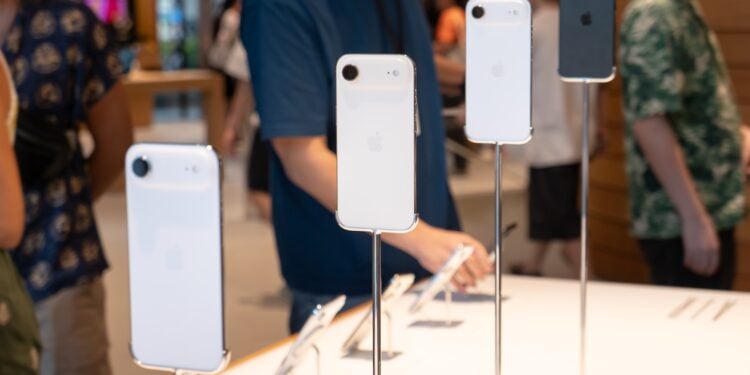The iPhone Air is Apple's new lightweight device, designed to offer the ideal balance between mobility, performance, and price. The smaller battery is one of the device's most noticeable compromises. However, recent tests show that the iPhone Air still easily gets through the day in everyday use. Both real-world usage and rigorous lab tests confirm that the battery lasts well despite its smaller capacity—and in some scenarios, it can even keep up with the larger iPhone models.
Apple deliberately designed the iPhone Air to be slimmer and lighter than the classic models in the iPhone 17 series. This meant saving space in the battery. Despite this, Apple fine-tuned the efficiency of the hardware and software to ensure amazingly robust battery life. The battery lasts for a full day with typical use—and this applies to both lab tests and real-life use. A closer look at the measurements and observations reveals just how good the iPhone Air's power management truly is.
Lab tests: Same endurance as the iPhone 17 Pro
CNET has been testing smartphone batteries using the same methods for three years, providing reliable comparison data across multiple iPhone generations. In the latest tests, the batteries of the new iPhone 17, 17 Pro, 17 Pro Max, and iPhone Air were examined – and the results were surprisingly positive.
In the video streaming test, which involves playing videos over Wi-Fi for three hours at maximum screen brightness, the iPhone Air 15 lost % of its battery capacity. This is exactly the same as the iPhone 17 Pro, putting it on par with the iPhone 15. The other models performed slightly better:
- iPhone 17 Pro Max: 9 %
- iPhone 17: 11 %
- iPhone 17 Pro: 15 %
- iPhone Air: 15 %
This test is particularly demanding, as maximum screen brightness and continuous streaming consume significantly more energy than normal everyday use. The fact that the iPhone Air performs just as well here as the more powerful models shows that Apple has done a lot of things right with energy management.
45-minute endurance test: Weaknesses under high load
A second CNET lab test simulates particularly intensive use. The iPhone is used for 45 minutes for power-intensive tasks such as gaming, video streaming, and video calls. The percentage of battery charge lost during this time was measured. In this scenario, the limitations of the smaller battery were more clearly evident. The results at a glance:
- iPhone 17 Pro Max: 1 %
- iPhone 17: 2 %
- iPhone 17 Pro: 2 %
- iPhone Air: 5 %
The iPhone Air lost more than twice as much power as the larger models. This means that with continuous, intensive use, the battery drains significantly faster. However, this is less of a factor for normal use, as most everyday activities consume less power.
Everyday test: A day without recharging is possible
In real-life use, the iPhone Air proved to be significantly more comfortable. According to Abrar Al-Heeti, senior technology reporter at CNET, the battery regularly lasted a full day with normal use. At the end of the day, around 20 mAh of battery life remained. Only on particularly intensive days—such as those with extensive camera use, long video calls, or navigation—did the battery level drop below 20 mAh.
Al-Heeti emphasizes that the iPhone Air performed reliably throughout her testing weeks. This means that real-world usage corresponds to the results from the lab tests: While the battery is smaller, it is easily sufficient for typical usage scenarios.
Charging speed: Halfway in half an hour
If the battery does need to be recharged, the iPhone Air proves to be efficient. In a 30-minute test with a 20-watt adapter, it achieved 49% battery life. This is exactly the same as the iPhone 16 and iPhone 15 Pro—and thus ahead of the iPhone 15 Plus. This makes the device ideal for short charging breaks, even if it doesn't set any new records for wireless charging.
Small battery, strong performance: The iPhone Air keeps up with
The iPhone Air proves that a small battery doesn't automatically mean short battery life. In lab tests, the device performs in a way that's barely different from larger models. Only under heavy, continuous load does it lose power more quickly. In everyday use, however, the battery reliably lasts a full day, even with mixed use of social media, photos, streaming, and messaging.
Charging times are also on par with more expensive models. The iPhone Air demonstrates that Apple has found a good balance in terms of energy efficiency and battery management. Anyone looking for a lightweight, compact iPhone that reliably lasts throughout the day will find the iPhone Air a perfectly balanced solution. (Image: Shutterstock / Wongsakorn 2468)
- Apple continues to grow: iPhone boom drives market value to 4 trillion
- Apple's service revenue is expected to reach $100 billion for the first time
- Threads introduces ghost posts – posts that disappear
- WhatsApp introduces new storage management for individual chats
- EU criticizes Meta and TikTok for lack of child protection
- Apple remains strong: JP Morgan now sees price target at $290
- Apple held an exclusive Vision Pro event for developers
- Swift SDK: Android support marks a turning point for Apple
- Apple significantly expands AirPods production in India
- iOS 26.1 introduces stable photo backups for third-party apps
- Apple in leak trial: Fanboy seeks out-of-court solution
- M5 MacBook Pro teardown: top performance, repair flop
- Apple surprises with strong growth in Mac sales
- Apple accelerates US production for its own AI servers
- Vimeo expands 3D support for Apple Vision Pro
- Is Apple withdrawing app tracking protection due to EU pressure?
- Future iPhone could have greater NFC range
- iPhone Air: Production drops drastically after sales slump
- Apple stock in focus: Wells Fargo raises target to $290
- Apple Vision Pro not eligible for trade-in, according to Apple
- Apple is working on a tool for app data migration to Android
- iPhone Air weakens – Apple relies on other models




